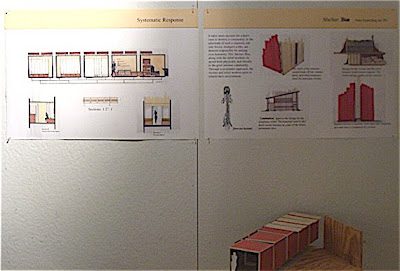Systematic Response: A Call and Response Structure that provides aid to disaster victims, by means of education, collaboration, and materials for society rebuilding.
It takes mere seconds for a hurricane to destroy a community. In the aftermath of such a situation, outreach forces, strangers alike, are responsible for uniting over humanity. This Shelter: Bus, along with the subsequent relief workers, respond both physically and literally to the grief stricken community. In a systematic approach, the victims and relief workers unite to rebuild their environment, as well as alter their view of humanity.
The Structure is so much more than a Bus, rather it is a communal bond, an initiator of good design. When disaster strikes, the bus provides a new beginning and a better future. It literally gives back to the community. The outer shell is comprised of lumber, material which the community will use as temporary disaster homes. The victims will be educated by the relief workers on how to effectively build said temporary sites. As time passes and the permanent homes are under construction, the temporary sites will be dismantled, and the material will be incorporated into the permanent houses. This would include the bolts and fasteners, as well as the lumber for framework and floorboards. In the end, the shelter: bus would forever be a part of the built community it revived.
In the beginning of the project, I knew that I wanted my shelter: bus to be more than a temporary relief vehicle; something that aided the disaster site, and then left. I saw my project being a part of something more substantial and permanent. Also, it would reinforce the idea that design can unify; it can create positive change. It can also come from the most unlikeliest of sources, even something seemingly simple as a bus.
While researching, I was drawn to the design of the human body. It is both intricate and very easy to relate to. The appeal of unification brought me to the nervous system. Essentially, it is a central call and response network. Feelings, ideas, sense, all depend on the nervous system. It is comprised of small components that branch out from a central station. The interior of the bus consists of systematic design. The space is open, divided only by a system of glass panels. The panels designate appropriate space for the relief workers and their needs; there is enough privacy without creating separation. There is nothing in the space that is not composed of smaller entities. Each scale is taken into consideration from the most detailed, to the most broad. For example, the color choice is based on layers and mixing; a system is used when processing secondary colors for they are a combination of primary. The wood in the structure embraces the grain and blemishes, displaying the systems and beauty found in nature. On a larger level, each portion of the bus is connected by, not only a datum line, but a series of glass encasings. The glass unites the structure, all the while highlighting the separation of spaces. There is not one piece in the composition of the bus that does not contribute to the greater whole.
. After the bus responds to the community, the remaining core would be a statement in itself. It is the brain of the operation; the workers reside there, as well as respond from there. Though obscured by the outer shell, it was present throughout, simply more so after the process concludes. Essentially, the core, or brain of the bus would remain, and the shell, or nerves of the bus would forever be dispersed throughout the community.
Diagram
Section A:
Displays that the spaces would be divided only by glass panels. The opacity of the glass would vary according to the need for privacy.

Section B
Everything in the Bus has a system. The bus is broken into three areas; public, semi-private, and private. This space is the eating and living area, a public space.

Section C

Details











No comments:
Post a Comment